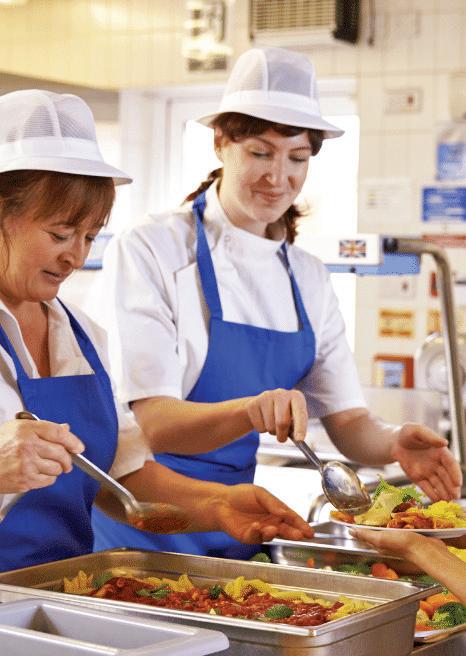





















Much of the feedback being shared regarding the Ka Ora, Ka Ako Healthy School Lunches programme has centred around the inconsistency of different suppliers, with the more positive feedback seeming to come from schools who have opted to either completely make lunches on-site or have a mix of supplied and made on-site.
For example, Peria School is a Far North school that cooks all meals on site. Its 63 students receive everything from bento bowls to quiche, sandwiches, sushi, wraps and soup.

Principal Ariana Williams said her school had been part of the programme since 2021, with funding covering the cost of chefs, food, and other additional expenses.
Williams explained when the school first started, it had no commercial kitchen, so had used the school’s 5YA money to build one in an unused building.
“We now have a fully operational commercial kitchen on site and three chefs, who are parents of students at our school. They all work on different days to make the lunches, with one supervisor chef who creates the menus each week.”
Teachers and parents are praising schools that create their lunches on-site, explaining that getting kids and the community involved only elevates the programme from one that simply feeds hungry children, to one that has learning opportunities.
Making school lunches on-site also minimises waste as there’s more control over what goes into the lunches, plus there’s no (or minimal) takeaway packaging to get rid of.
Those who have success with external suppliers agree that communication is key, and that menus and dishes should continually evolve to the best combination of what children want and what they need. All those involved are working towards the same goal after all, to successfully feed hungry Kiwi kids.
Tania Walters, PUBLISHER
a
&
of Restaurant
to
EDUcatering
EDUcatering
Copyright
Restaurant & Café EDUcatering is
Restaurant
in
with
publication to Restaurant
and

Large amounts of food waste are being reported by some schools because the students don’t want to eat the lunches provided to them through the Ka Ora, Ka Ako | Healthy School Lunches programme, according to recent stories in the media.

The Ministry of Education initiative, which aims to reduce food insecurity by providing access to a nutritious daily lunch, started in 2020. By August 2022, over 63 million lunches have been delivered in 950 schools and kura to over 220,000 learners.
But not every child is keen on the items being served. Feedback from students, especially younger children, is that they would like to eat a simple sandwich, packet of flavoured crackers or chips and a piece of fruit for lunch, but what they are being served is far more complex.
By aiming to be super health focused, the government programme seems to have lost sight of what kids actually want to eat.
I grew up on mostly packed lunches – the typical sandwich made with white bread, a mini pack of Poppa Jacks, a mandarin, and a “fruit” roll-up – remember those! Basically, a flat square of chewy sugar. Once a week I’d be allowed to order from the tuck shop – usually a mince and cheese pie and juicy.
While the fact that foods like “fruit” rollups have been phased out is definitely a good thing for childhood health, most of what I ate, while pretty standard for my peers and
I growing up, wouldn’t be allowed under the Healthy School Lunches programme.
I turned out fine though. I have a healthy relationship with food, I like vegetables, I didn’t turn into a pie addict. So, what’s so wrong with giving kids a ham sandwich made with white bread if that’s what they will eat?
Of course, there are plenty of schools and students who love the lunches they are provided. The comments on social media regarding school lunches are a mixed bag, ranging from:
“The lunches, at the school where I am a teacher, are delicious!”
“We have amazing lunches at our secondary school - made fresh on site each day. Sandwiches made with Freyas bread, wraps, pita pockets, salads… I can’t praise the school lunch programme highly enough, absolutely it won’t be for everyone, but in our kura it has been a tremendous success.”
“My children very much like the lunches and so do I, a great initiative. My children, like many, have gotten used to trying new things and have ended up liking them.”
TO: “Sorry but my daughter goes to High School, and she is grateful, but most of the lunches are disgusting. She sends pics home
because she wants us to see what they are serving.. The teachers ask what’s for lunch and then decide to eat out instead.. What does that tell you??”
“Have you tried them yourselves? I have the menu the kids get and some of it is gross.”
A key takeaway from much of the feedback has been that schools seem to have more success when they make the school lunches onsite, rather than having them supplied.
“Our school has lunch ladies that make each meal, and the menu always looks great!”
“So glad our school cooks fresh, healthy, nutritional food onsite! My daughter never used to eat her food. Over the last 2 years she’s changed her eating habits for the best!”
“Time to get serious and provide commercial kitchens within all schools with onsite cooks like they do in other countries.” Does the Ministry of Education need to update its advice on how to create healthy school lunches that kids want to eat, or is the solution more commercial kitchens in schools where children can be involved in the preparation process?
Whether you’re a school, kura, or supplier, we’d love to hear your thoughts about school lunches for kids, contact sophie@reviewmags.com H


Associate Education Minister Jan Tinetti has announced that the Government is continuing to invest in teachers and students, through a multi-million-dollar package to boost teacher supply and provide extra support for young people whose learning has been disrupted by COVID-19. “Teacher supply has long been a priority for us. Ensuring we have more teachers is vital to ensure our kids are getting the education they need.”
Education Minister Chris Hipkins added that as well as increasing teacher supply, the Government is also ensuring New Zealand’s young people, whose learning has been disrupted by COVID-19, won’t fall behind.

“We know that young people have missed some crucial time in the classroom
throughout the last two and a half years and we need to address the impact of that headon.” Read more here.
Improved student achievement is a step closer with the launch of Hei Raukura mo¯ te Mokopuna (Te Reo Matatini me te Pa¯ngarau) and The Literacy, Communication and Maths Strategy action plans. “We are making some much-needed changes to the way we support the teaching and learning of literacy and maths.
They include the introduction of a standard teaching model (common practise model) which will mean that teaching in these areas is consistent.
We’ll also ensure that our teachers are well supported to deliver teaching and learning that fits their learners’ needs.” Read more here.
In 2023, the Ministry of Education will move from using the decile system to distribute equity funding to primary, intermediate, and secondary schools, to using their newly developed Equity Index (EQI). “There are advantages in introducing this new system, but there are also risks.”
Read more here.

Education New Zealand (ENZ) has allocated $1.6 million to six “innovative” education specialists as the country’s sector adapts to the post-Covid environment. The six awardees will be handed support ranging from $200,000 to $300,000 for individual projects over the next 12 months. “The quality of the entrants was a clear indication of New Zealand ingenuity, market knowledge and cutting-edge innovation.” Read more here.


More young minds eyeing food and fibre careers is the aim of new Government support for agricultural and horticultural science teachers in secondary schools. “New Zealand’s food and fibre sector is the backbone of our economy and is how more than 367,000 people earn a living. We’re working hard to build resilience and meet future workforce demand as the sector grows.” Read more here.
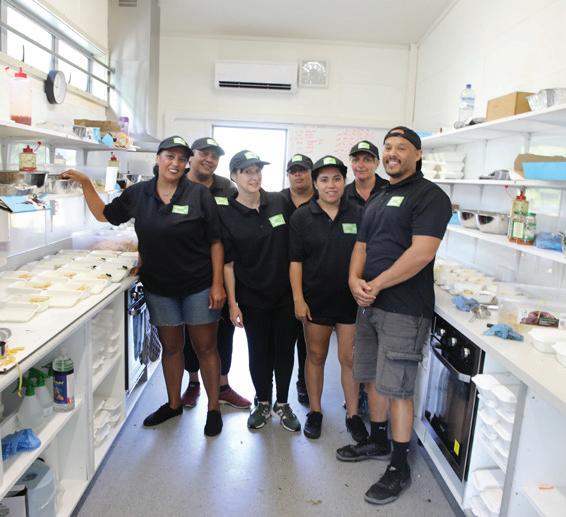



• Top quality, freshly made lunches for learners.
• On-site or delivery service, tailored to suit you.
• Professionally audited food control plan.
• Trained, qualified, local staff.

It’s simple: Our professionals feed hungry students, while education professionals feed hungry minds.
Find out more at www.libelle.co.nz

Considering the current conversation surrounding the Healthy School Lunches programme, Educatering magazine wanted to get some insight from a tendered supplier about how they go about creating school lunches that kids love to eat.

Other concerns for schools and suppliers include price inflation and ways in which businesses are mitigating this, while still providing highly nutritious meals to Kiwi school children.


Educatering magazine talked to Lunch by Libelle, a proudly family-owned Kiwi business that has been serving hungry learners healthy and nutritious food in all corners of the country since 2004. They have been a preferred supplier for the Ka Ora, Ka Ako | Healthy School Lunches programme from the very beginning in February 2020.
The team at Libelle have felt the recent price rises, and not just for fruit and vegetables, but across the board.
“Every household knows it and we do too. It’s been another tough element to a uniquely challenging time,” expressed Johannes Tietze, Founder & Executive Director Libelle Group.
“This has been a spur to us to invest time and effort in new ingredients and suppliers. Innovation and efficiency are key to our cost control and planning to keep prices down and nutrition up.”
For Libelle, it comes down to a lot of creative thinking and the ability to stay flexible.
“We have really drilled down into what the Ka ora, Ka ako programme offers our children and focused on providing food groups often missing in many children’s diets – wholegrains, proteins and vegetables.”
Tietze noted that hot meals are a great format to deliver these food groups in a
tasty way. For many children it can be more palatable than sandwiches, rolls or fresh salads, so Lunch by Libelle are keeping hot meals on the menu all year.
LIbelle is also big on seasonality. Produce at its most plentiful, most affordable and in prime condition is central to meal planning and nutritional delivery. The business has been in school nutrition for nearly twenty years now and has long-standing supplier relationships where it can collaborate to fight higher costs while retaining a high quality.
“We are lucky to have suppliers as committed as we are to feeding hungry learners, but it’s a constant focus right now.”
Feedback from students is essential to meeting their nutrition needs, which is why feedback is built in at every stage of Libelle’s service, from students and the wider school community, both formally and informally.
Libelle’s key innovation is its FEAST workshops, (hands-on food education classes) it runs with each of its schools at least twice per year.
“In FEAST we korero with the students about meal preferences, engage their curiosity about how Libelle lunches are healthy and balanced, and extend their flavour range as well as knowledge and vocabulary around food and eating. We watch, listen, and learn at least as much as they do, making, eating, and talking food.”
Menu development is ongoing at Libelle. Led by nutritionists and informed by various feedback channels, Libelle’s on-site kitchen teams hate waste and love feeding students, they are an essential tool for insight on both waste and what wins on its menus.
“Our delivery teams are on site with the students daily, looking and listening. This is then reported to our Menu Advisory Committee, who regularly review meal and recipe feedback. Atop this, our regional leadership teams meet regularly with Principals and school business managers on every element of our service and at the heart of this, is menu and meal popularity.”
As every parent knows, feeding children is a
challenging job! Libelle completely understands that children want what they know, and what they know is not always what will provide the best nutrition. They also understand the dynamics of a feeding relationship.
“Alongside providing meals that will be familiar we work hard to share our knowledge with our teams and our schools so that together we can provide a safe and supportive environment for our students to learn to eat a variety of foods and to learn about food in a constructive way that will support them to make healthy food choices later in life.


“This is where our FEAST workshops are so important, educating students on why they’re eating what they’re eating, rather than feeding them without explaining the benefits.”

One piece of advice from Libelle is that it is crucial to create and practice a robust
nutrition culture within a school. It does not need to be the same as at home, but it gives a sense of belonging, a sense of “this is what we do here”.
Create a ritual around eating times and provide a safe, loving space for eating to happen. Encourage ownership of this space
and time. Practice hands-on reconnection with food – through gardening, foraging, art classes, food preparation, building a recipe, baking, reading food books, and learning about how the body works. Research shows that this will support a child to have the confidence to try new foods.
Be mindful about the language used around food and eating – keep it neutral about the food, encourage extension of vocabulary about the food and keep the pressure to eat the food off.
“Children look to us to learn how to react and behave around food, so be a positive role model,” noted Tietze.
“Encourage respect – it’s ok to not like the food, but it is never ok to be rude about it. Don’t yuck someone else’s yum!
Our FEAST workshops, for example, are proven to increase uptake following completion. Why? Because children understand the why of what they’re eating and are keen to grow strong and healthy!” H

Set students up for a great end-of-year break with a sensational summer menu, taking advantage of the fresh produce and bright colours associated with the season.
Research suggests that it is, in fact, our eyes that lead the way when it comes to the enjoyment of food, and our tongues merely follow.
The same is true for kids.
When our eyes see food, they translate what the food will taste like via a series of learned and natural responses. It’s the learned responses that are important for children. By being exposed to new foods that look great, a child’s taste preferences expand.
Summer is the perfect time to mix up the colour palate to get kids eating nutritious and delicious meals.
The idea of a fritter may seem unhealthy at first, but it’s all about the ingredients and preparation - making sure to use lots of vegetables and cook with a low-cholesterol vegetable oil. Adding peas (or an alternate vegetable such as courgette or carrot) not only adds extra nutrients, but it also that pop of colour that makes these fritters so much more appealing to the eye.

Burritos are delicious, filling, they look great and are easy for little hands to eat. They are the perfect way to get kids to try different vegetables and introduce them to dishes and flavours from another part of the world.


Be sure to use lean protein such as chicken breast (alternatively you could use fish, it’s also easy to create a vegetarian version) and lots of summer salad favourites like grated carrot, cucumber, and avocado. If using tomato, finely dice it to avoid making the wrap soggy. If adding cheese use low fat cheese, for example, edam, reduced-fat cheddar, or reduced-fat tasty cheese.
You can make your burritos pop by adding
pineapple salsa – a simple and sweet take on Mexican-style cuisine that will have the kids buzzing and provide them with an extra source of vitamin c.

Feel the colourful vibes of summer with Vege Sticks and Bright Beetroot Dip.

Mix up the colours of the vegetables to make this snack super appealing to the eye – beetroot dip is bright pink and can be a fun alternative to the usual beige hummus.
Funk the menu up with Fruit Salad.
Be sure to use a variety in both colour and texture, and can be served with low-fat yoghurt for that extra protein punch. H

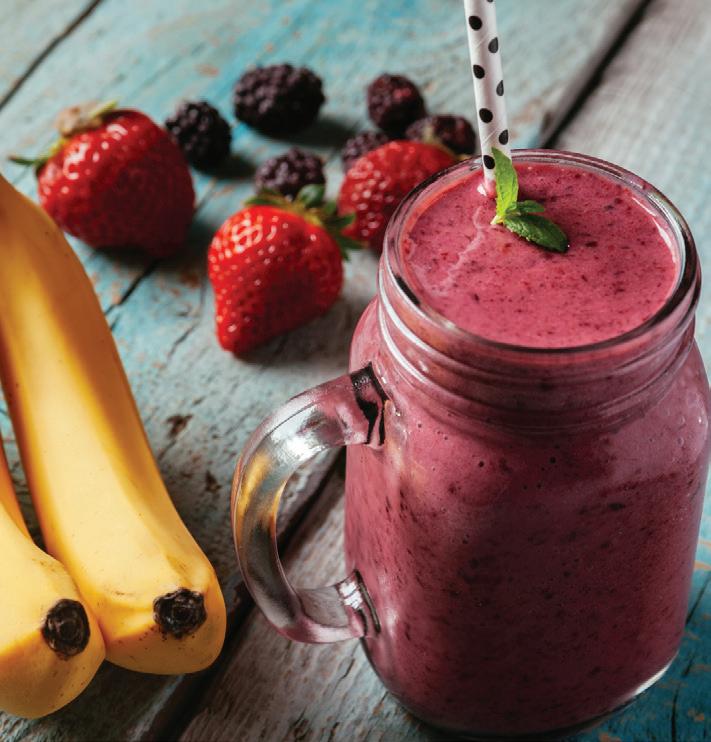
The Tootie Fruity: Banana, fresh or frozen berries, milk (or milk alternative, such as soy or almond)




The Smooth and Sweet: Banana, avocado, milk (or milk alternative, such as soy or almond), plain, unsweetened yoghurt (or dairy-free equivalent)

The Kakariki: Banana, spinach leaves, milk (or milk alternative, such as soy or almond. Alternatively, you could try a dairy-free version using a low-sugar apple juice), fresh or frozen chopped fruit (such as apple, pineapple, or kiwifruit)












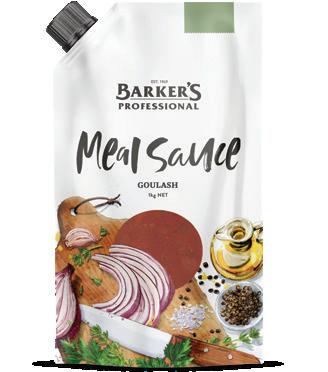

Children’s tastes vary. It can be challenging to provide healthy food that children want to eat and getting children to enjoy new foods can take time. The Ka Ora, Ka Ako | Healthy School Lunches Programme Healthy Food and Drink Guidance identifies the healthy options for foods and drinks in schools.
It classifies foods and drinks as green, amber and red. As a minimum standard, no red items should be included in school lunches. Red items are high in fats, salt, and sugar with
• Are a good source of nutrition.
• Generally lower in saturated fat, salt and added sugar.
• Are mostly whole and less processed .
• Come from the four food groups: vegetables, fruit, wholegrains, low fat milk products, and legumes, seafood, eggs, and meat with fat removed.
no nutritional value. They are often highly processed and eating lots of these contributes towards poor health.
Lunches should be made up of amber and green items. As suppliers transition

• Are not part of an everyday diet.
• May have some nutritional value.
• Are often more processed.
• In large servings, can contribute to consuming excess kilojoules/calorie.
towards offering healthier menu options, the proportion of green to amber items should increase and the frequency of amber items per week should decrease.
For more information, visit www.education.govt.nz H
• Have poor nutritional value
• Are high in saturated fat, salt and/or added sugars
• Can contribute to consuming excess kilojoules/calories.
• Are often highly processed food and drinks.





lunch boxes - every small, kind act, makes a huge difference for some of our tamariki.”
In response to KE, the students have reported that they enjoy coming in and spending time with others, noting that “this is our safe place.”
Tuaoi explained that as the school is large, it is a challenge to find some of the students who are more vulnerable, so it is hoped that they are identified through their teacher or that they hear about the breakfast club from their friends.
“We advertise our club via our television show, Cactus, we have fliers in every classroom, and we rely on word of mouth. Some staff members have said that it is a great thing that we are doing for our students. It’s nice to see them at school and have them come up to our staff and say hello out in the playground.”
Leisha Tuaoi, a teacher at Glen Eden Intermediate in Auckland, saw a need to provide access to food for some of the school’s students.
While the school of just over one thousand year 7-8 students is not a part of the Ka Ora, Ka Ako programme, it recognised that providing an essential necessity such as kai, enables children to be able to learn, think and grow te taha tinana (the body) and to grow to hinengaro (the mind).

“It is our philosophy to support our tamariki, uphold their mana and integrity, build positive relationships, and provide an opportunity for students to grow and be at their best,” explained Tuaoi.

With that in mind, the Kai Express Breakfast Club (KE) was born.
“We offer kai in the hope that we can achieve some of these goals and offer opportunities for changes that might make life a little easier for some of our students. Since Covid, many communities have struggled, and we have had some whanau who have needed to reach out for support.”
All students at Glen Eden Intermediate are welcome to attend the breakfast club and are encouraged to bring a friend. The breakfast club operates from Monday to Friday during the first break 10.15 – 10.30am (in the hope of capturing students who come to school

late in the mornings).
The school also offers a basic lunch for students to collect, containing things such as muesli bars, crackers, and biscuits.
“We are a ‘one stop shop’ as we offer breakfast, lunch and feminine products for our students through a programme organised by one of our teachers, Nicola Pitcher.”
Kickstart Breakfast, a joint initiative between Fonterra, Sanitarium and the Ministry of Social Development provides the school with milk and Sanitarium Weetbix. The school also receives kind donations of cereal, fruit and sometimes crackers from VisionWest, West Auckland. “Junior Tavai from the Youth Hub West, who provides Affirmation and Leadership programmes at GEIS, often drops in snacks to pop in
Tuaoi said the school’s Principal, Maree Stavert, has fully supported the initiative and provides food items. She has, over many years, built positive relationships with VisionWest, West Auckland, so the school can work together with them to make things work for the children.

“It has been a great team effort. Since opening the breakfast club our teachers, at different stages, have all played different roles in our team (Pam Hooper-Corbett, Sara Badawi, Anne Wooster, Christina Jones, Nichola Leslie, Vaimoana Va’ai, Anna Evans).
“I love the impact that our club has had on some of our students as they have blossomed in confidence and always offer to help set up and pack down at breakfast time,” concluded Tuaoi.
“They meet new friends and build positive relationships with staff. Hopefully, we make a small difference in the lives of our taonga.” H

Need help with supplying quality lunches? We have everything you need, so put Gilmours on the menu today. gilmours.co.nz
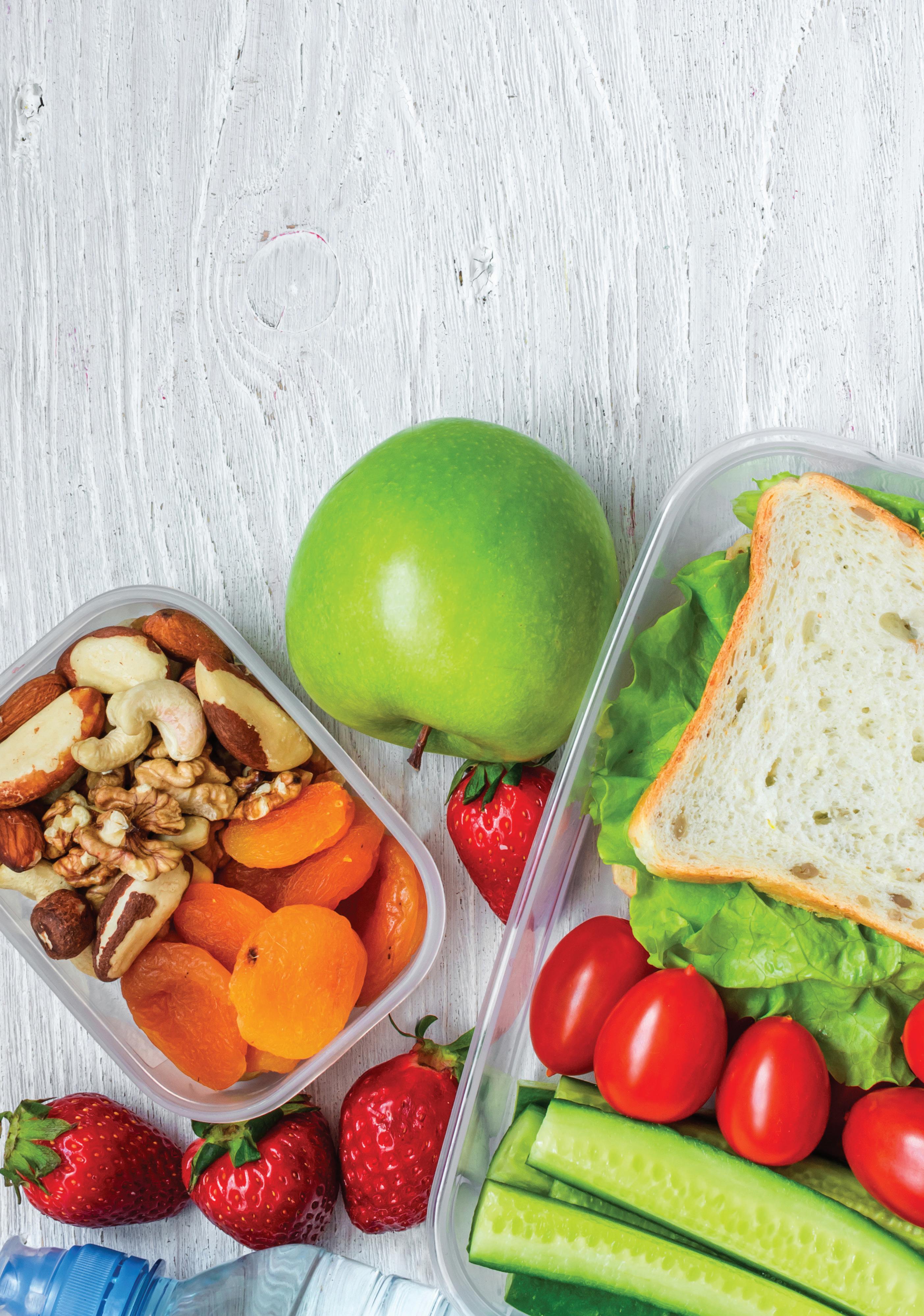
VIBE, a company bringing delicious sugar-free drinks to schools and other outlets, has entered into an exciting partnership with Diabetes NZ.
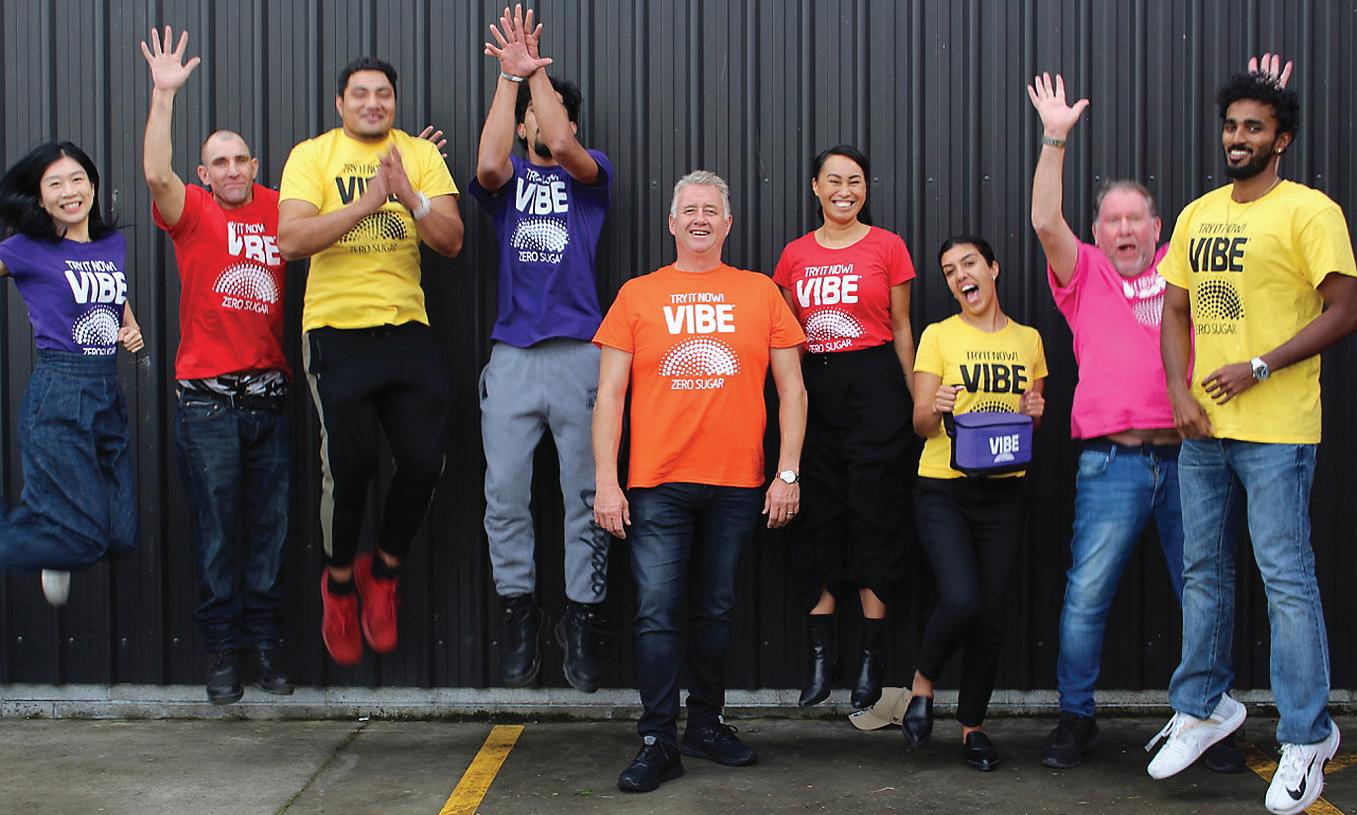
Heather Verry, Diabetes NZ CEO, has welcomed VIBE to the organisation’s elite group of Champion Sponsors. It’s a very positive move toward increasing awareness of the importance of reducing consumption of sugar in beverages. She noted that limiting sugar intake is pivotal to improving health outcomes in the community, reducing the risk of obesity, type two diabetes, and ultimately the longterm complications that can develop later in life.
“We’re delighted to be working with Diabetes NZ. I have type two diabetes myself, so it’s important to me that all the ingredients used have been signed off by Diabetes NZ,” said Stefan Crooks, managing director of VIBE.

VIBE was born from a conversation about improving the products their existing school food supply business offered. ‘VIBE was created to provide a great-tasting alternative to sugary drinks – one that allows kids to enjoy a carbonated drink full of flavour but with zero sugar.’
As VIBE is now available at schools across New Zealand, “it allows for strong opportunities to educate school principals on
the importance of nutrition intervention, as they have the power to influence children’s knowledge and behaviour,” said Verry.
The New Zealand Health Survey 2018/2019 found that approximately one in nine children (aged two to 14) were obese, with an overrepresentation in Māori and Pacific communities.
“Today’s consumers are looking for products like VIBE that support their emotional, indulgent, and physical health needs, ranging from relaxation to hydration. They want less sugar – no question. But they also don’t want to sacrifice taste,” said Crooks.
VIBE concentrates on the quality of its natural flavours, which are made from New Zealand ingredients.
“Consumers are not only demanding functional drinks that don’t compromise on taste, they’re also looking for companies that adhere to a sustainable ethos. “That’s why there’s no plastic used on VIBE products. Our clear can design and branding highlights the aluminiumcan packaging and encourages recycling.”
Diabetes NZ is looking forward to extending the messaging about good nutrition in partnership with VIBE. H
Limiting sugar intake is pivotal to improving health outcomes in our community, reducing the risk of obesity, type two diabetes, and ultimately the longterm complications that can develop later in life.





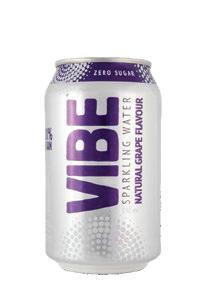

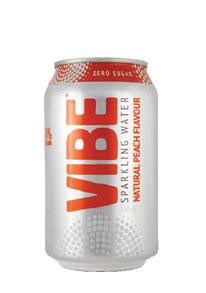

These days, just about all takeaway packaging products are “recyclable”, however only some products are biodegradable and compostable. So, what’s the difference and why is it important?

with importers now placing huge reductions on the number of plastics allowed in their processing lines.
Recyclable: Recycling isn’t as simple as it should be. If a package is labelled recyclable, it means the packaging could be recycled if the material is clean and not contaminated with greases and oils, and if the local council/waste management contractor has processes in place to actually recycle the material.
Unfortunately, New Zealand recycles very few plastics, and it is now becoming more difficult to sell our recovered plastics overseas,
Biodegradable: This means that the material will break down (degrade) faster by undertaking specific biological processes. “Bio” means that living organisms will increase the degradation of a material. Biodegradable materials are not always compostable, as some biodegradable plastics are still petroleum-based plastics and take hundreds of years to degrade.
Making petroleum-based plastics biodegradable does not make them a green option, it simply speeds up the decay and the plastic molecules just become smaller (and more dangerous) sooner than later. Petroleumbased plastics should be recycled and not designed to biodegrade.
Compostable: This means that the material
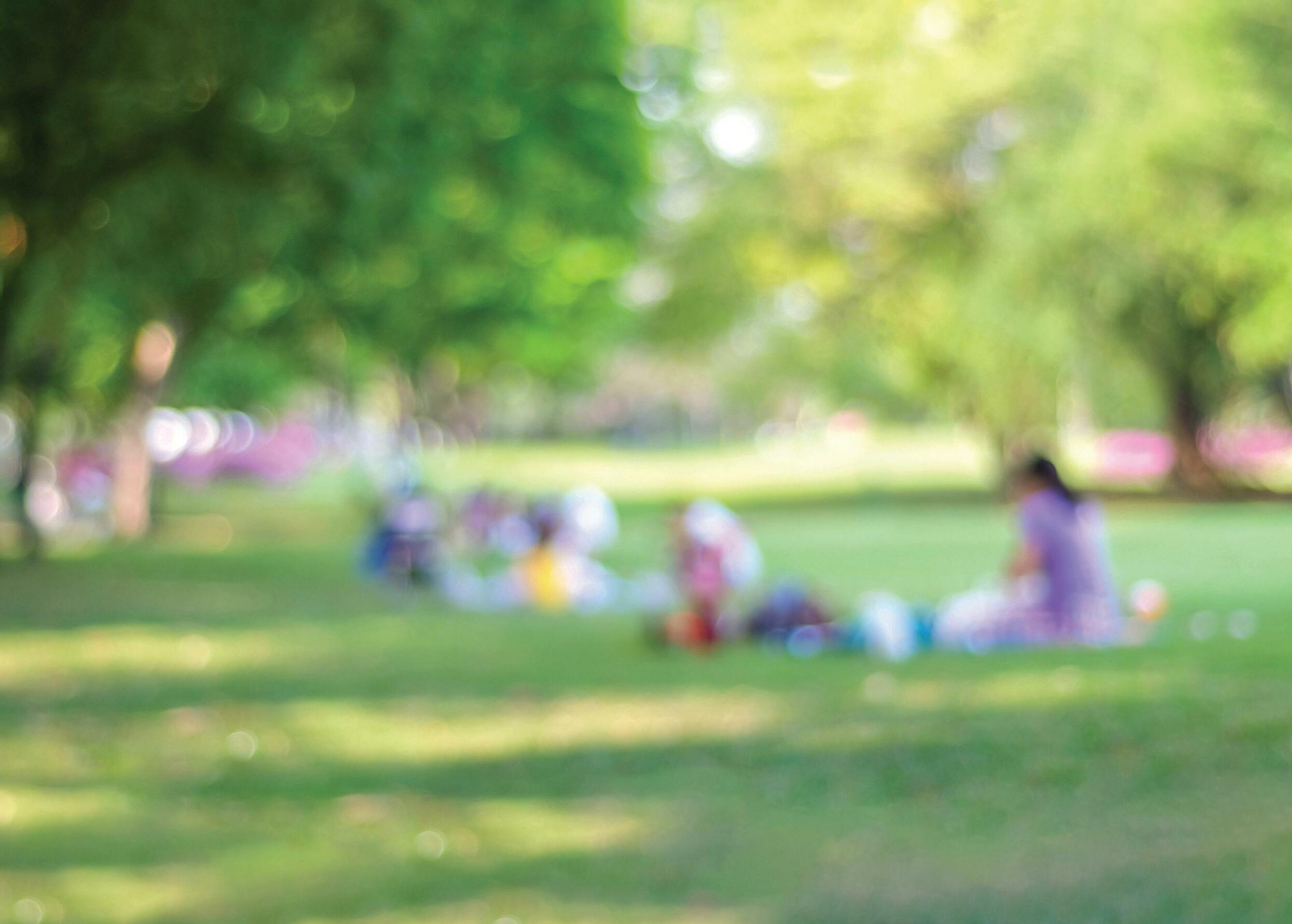
is made of organic matter, it will naturally biodegrade, and, in the right conditions, it can be converted into compost.
The length of time it takes for an organic material to break down depends on the conditions in place (temperature, moisture, air, pressure) and the material. This is all very difficult to accurately ascertain as the conditions vary so much. All plant-based products are biodegradable, and breakdown can take a few weeks to a few months.
Plant-based materials to look out for include kraft cardboard, sugar cane, bamboo, and plant starches – these naturally break down and can become compost in the right conditions. H


CHOOSE TO MAKE A DIFFERENCE.”

This is a great simple dish that is delicious served both hot and cold, meaning it’s perfect all year round and can also be made in advance. The other great thing about this recipe is that it can be changed up by using vegetables that are in season and plentiful. Mix it up with different combinations.
Nutritional Notes: The Ka Ora, Ka Ako Healthy Food and Drink Guidance recommends using wholemeal pasta; however, plain pasta is within the Amber (okay sometimes) category so this dish could be a weekly special rather than a regular occurrence. When it comes to cheese, the Guidance recommends reduced- or low-fat products and a portion size of less than 40 grams. Again, full-fat cheese (40g portion) is within the Amber category and can be used on occasion.
(for a 12-hole medium muffin tray)
• 2 cups macaroni (or small pasta)
• 2 courgettes, grated
• 1 carrot, grated
• 1 cup grated cheese
• 8 eggs
• ½ cup low-fat milk
• Heat the oven to 180°C.
• Cook pasta by following the instructions on the packet. Drain and rinse in cold water.
• Lightly grease a 12-hole medium muffin tray.
• Mix together cooked pasta, grated courgette, carrot and about ¾ cup grated
cheese in a large bowl.
• Divide the mixture evenly across the greased muffin tins.

• Whisk together eggs and milk in a large jug. Add a little black pepper, to taste. Pour egg mixture evenly over the vegetable mixture.
• Sprinkle with remaining cheese.
• Bake for 18 to 20 minutes or until cooked through and golden.
• Stand in the tin for a few minutes before running a knife around the outside of each frittata and lifting out.

To mix this recipe up, try different vegetable combinations, for example, frozen peas or corn, chopped red or green pepper, grated kūmara or grated pumpkin or for nonvegetarian version, try with canned tuna or salmon, chopped ham or chopped cooked chicken.
Recipe courtesy of healthykids.org.nz H




It’s time to say goodbye to linear thinking. A linear economy can be defined as when products are made, used, and then disposed of, with their materials lost to landfill. In a recycling economy, the materials from a product or its packaging can be utilised by other suppliers into other products.
Acircular economy takes this even further by creating a process where materials are recycled and reused over and over again by the manufacturer, who takes responsibility for the lifecycle and end-of-life of what they produce. Businesses can effectively take their old products and turn them into new ones.
Recycling is essential for businesses and schools to reduce their environmental footprint and reduce waste disposal costs. Understanding your current waste habits will allow you to adapt your waste system to be as effective as possible.
Any waste audit should start with a Procurement Assessment.
What goes in must come out. A first step to assessing your organisations waste is to ensure you are not purchasing products that are not recyclable. For most inefficiencies, there is a
company making a sustainable solution.
Reduce: Ensure you are engaging with sustainable suppliers.
Reuse: Are there single-use products that could be exchanged for reusable options?
Recycle: Check that there are not more sustainable alternatives for the products you purchase.
You can find handy DIY Waste Audit resources at www.methodrecycling.com/nz
Kids are the future, so enabling them with the right knowledge around recycling and sustainability now will help protect our environment in the future.

There are organisations around New Zealand that work with schools to help instil sustainability habits within students that they will then carry with them beyond the education system.
Enviroschools is a nationwide programme supported by Toimata Foundation, founding partner Te Mauri Tau, and a large network of regional partners. Early childhood centres and schools commit to a long-term sustainability journey, where tamariki/students connect with and explore the environment, then plan, design, and act in their local places in collaboration with their communities.
Every early childhood centre and school across the country is unique, with its own
ecology, history, culture, and community – so Enviroschools looks different in every setting. The journey of connecting with the place and its people is designed and led by each school or centre. You can learn more at www. envirschools.org.nz
Started in Wellington, the successful Your Sustainable School programme is going nationwide with help from the Ministry for the Environment. The programme offers Train the Trainer workshops to help roll out sustainability focussed, climate action, and waste reduction systems at your kura/school or kōhanga/early childhood centre.
How your kura/school or kōhanga/ early childhood centre will benefit from the Your Sustainable School programme:
• Better recycling systems and lower rates of contamination

• New or improved methods to deal with food scraps
• Spending less on waste management
• Changes to procurement and better opportunities for cafeteria suppliers and cleaners
• Empowered students and teachers driving a culture of climate action at school, at home, and in the community
You can learn more at www.sustaintrust.org. nz/your-sustainable-school. H
On top of helping to tackle climate change, it’s been estimated that Kiwi schools could cut up to $20 million a year off their power bills by using solar panels.

Down by more than half, New Zealand’s biggest school solar power system has slashed electricity bills at Kerikeri High School. The 174-kilowatt system eclipses what was previously the country’s biggest solar system, a 101kW solar panel array at Kaitaia College which opened in 2019. Kerikeri High associate principal Mike Clent said the move to solar power made a lot of sense.

Power costs in Kerikeri were among the highest in New Zealand and had increased by an average of more than 5 percent every year during the past decade.
At peak output, the system generated 60 to 65 percent of the school’s power needs and while the solar system, by SuperPower, cost a ‘’significant sum’’, Clent was confident it would pay for itself in five years. It had a projected life of 25 years so that meant 20 years of savings that could be directed into other areas of the school.
While the Ministry of Education does not have a preferred solar panel provider and is not
running a solar panel installation programme, several schools plan to install solar panels that have been funded through the Sustainability Contestable Fund. In these instances, the panels will be paid for with Crown funds and owned by the Ministry. The Sustainability Contestable Fund was established to support schools to reduce their environmental impact and improve their operational efficiency.
At the end of last year, New Zealand Green Investment Finance (NZGIF) announced it was continuing its investment in solar by providing an $8 million senior debt facility to finance solar panels on schools across New Zealand, alongside energy services provider solarZero.
The new energy initiative, called solarZero Schools, will enable Kiwi schools to convert sunshine into solar energy to power their school and contribute to an increase in New Zealand’s renewable electricity generation capacity. solarZero Schools provides solar energy services to schools for no upfront cost and with longterm fixed costs at a price below the current cost of retail electricity, making it an attractive option for schools.
“By financing solar panels on schools, we are helping demonstrate in a tangible way to future generations what a low carbon world can look like,” explained NZGIF CEO, Craig Weise.
“NZGIF’s finance will enable solarZero to deploy distributed solar across schools. This investment will accelerate the uptake of distributed renewable energy projects and contribute to the decarbonisation of the education sector.”
solarZero is taking registrations for the Schools programme now and initial interest is high. School principals interested in the joining the programme can register their school via the solarZero website. H

40-foot containers. These can be used by one school or shared as a central kitchen for several schools.
With costs spread across schools this approach can meet multiple dietary requirements/menus, reduce food handling and delivery costs, and can even be integrated with a school’s broader curriculum, working alongside such initiatives as garden to plate or linking horticultural studies right through to Home Economics.
This approach aligns with the view that schools and communities are best placed to understand what their students need. Schools and kura can decide whether to make their own lunches or outsource to an external supplier.
The Ka Ora, Ka Ako | Healthy School Lunches programme aims to reduce food insecurity by providing access to a nutritious lunch in school every day. Around a million lunches are provided each week. By August 2022, over 63 million lunches have been delivered in 950 schools and kura to over 220,000 learners.
Organisations involved in delivering the programme have been developing a range of solutions for food preparation, cooking, and handling/delivery with a view to lower costs and deliver the programme sustainably, maximising the amount of funding going into the food itself.
One offering that has been developed is a mobile, container-based kitchen.

Stoddart NZ and Host Services have teamed up to design and fit out both 20- and
Those schools and kura that outsource choose from a panel of approved suppliers that have met minimum standards of food hygiene, waste management and food preparation. There are a range of supplier models depending on what works best for each school, for example a single supplier or a mix of suppliers.
The Ministry holds the contract with suppliers so that schools do not have to worry about invoicing, payments, or any financial risks.
Schools and kura have the operational day-to-day relationship with their supplier so they can make decisions that are right for their students, eg adapt menus, update student numbers, and agree delivery times and requirements. H
